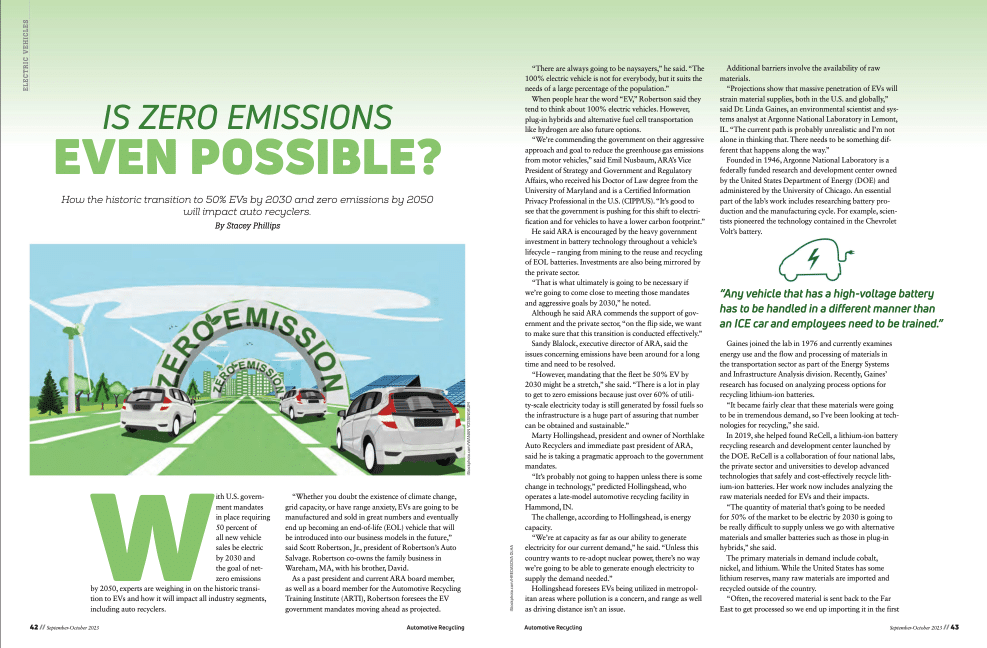How the historic transition to 50% EVs by 2030 and zero emissions by 2050 will impact auto recyclers.
Article written for Automotive Recycler’s Association Automotive Recycling magazine
With U.S. government mandates in place requiring 50 percent of all new vehicle sales be electric by 2030 and the goal of net zero emissions by 2050, experts are weighing in on the historic transi- tion to EVs and how it will impact all industry segments, including auto recyclers.
“Whether you doubt the existence of climate change, grid capacity, or have range anxiety, EVs are going to be manufactured and sold in great numbers and eventually end up becoming an end-of-life (EOL) vehicle that will be introduced into our business models in the future,” said Scott Robertson, Jr., president of Robertson’s Auto Salvage. Robertson co-owns the family business in Wareham, MA, with his brother, David.
As a past president and current ARA board member, as well as a board member for the Automotive Recycling Training Institute (ARTI), Robertson foresees the EV government mandates moving ahead as projected.
“There are always going to be naysayers,” he said. “The 100% electric vehicle is not for everybody, but it suits the needs of a large percentage of the population.”
When people hear the word “EV,” Robertson said they tend to think about 100% electric vehicles. However, plug-in hybrids and alternative fuel cell transportation like hydrogen are also future options.
“We’re commending the government on their aggressive approach and goal to reduce the greenhouse gas emissions from motor vehicles,” said Emil Nusbaum, ARA’s Vice President of Strategy and Government and Regulatory Affairs, who received his Doctor of Law degree from the University of Maryland and is a Certified Information Privacy Professional in the U.S. (CIPP/US). “It’s good to see that the government is pushing for this shift to electri- fication and for vehicles to have a lower carbon footprint.”
He said ARA is encouraged by the heavy government investment in battery technology throughout a vehicle’s lifecycle – ranging from mining to the reuse and recycling of EOL batteries. Investments are also being mirrored by the private sector.
“That is what ultimately is going to be necessary if we’re going to come close to meeting those mandates and aggressive goals by 2030,” he noted. Although he said ARA commends the support of government and the private sector, “on the flip side, we want to make sure that this transition is conducted effectively.”
Sandy Blalock, executive director of ARA, said the issues concerning emissions have been around for a long time and need to be resolved.
“However, mandating that the fleet be 50% EV by 2030 might be a stretch,” she said. “There is a lot in play to get to zero emissions because just over 60% of utili- ty-scale electricity today is still generated by fossil fuels so the infrastructure is a huge part of assuring that number can be obtained and sustainable.”
Marty Hollingshead, president and owner of Northlake Auto Recyclers and immediate past president of ARA, said he is taking a pragmatic approach to the government mandates.
“It’s probably not going to happen unless there is some change in technology,” predicted Hollingshead, who operates a late-model automotive recycling facility in Hammond, IN.
The challenge, according to Hollingshead, is energy capacity.
“We’re at capacity as far as our ability to generate electricity for our current demand,” he said. “Unless this country wants to re-adopt nuclear power, there’s no way we’re going to be able to generate enough electricity to supply the demand needed.”
Hollingshead foresees EVs being utilized in metropolitan areas where pollution is a concern, and range as well as driving distance isn’t an issue.


